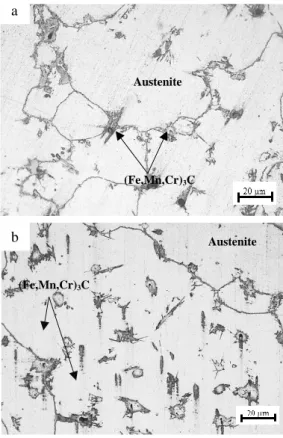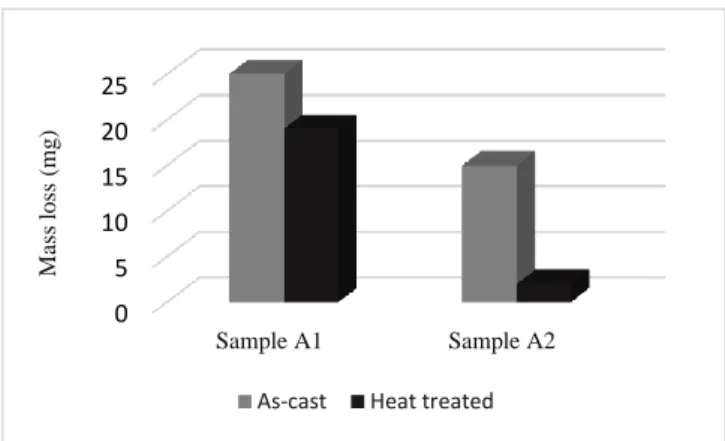Effect of Chemical Composition on
Martensitic Transformation and Abrasive Wear
Resistance of Hadfield Steel
AYADI Souad
1, HADJI Ali
11Laboratory of Foundry, University of Badji Mokhtar Annaba, BP 12- 23000 Annaba, Algeria ayadisouad14@gmail.com
Abstract - In this study, the effect of (Cr+Nb) inoculated
Hadfield steel on martensitic transformation and abrasive wear resistance was investigated and compared to standard Hadfield steel. Studied steels were melted in an electric arc furnace. Then, samples were subjected to two solution treatment, at 1080°C then at 1100°C. Optical microscopy (OM), scanning electron microscopy (SEM) and X-ray diffraction (XRD) were performed to estimate the microstructural changes after inoculation and heat treatment. Hardness measurements and abrasive wear tests were also performed to determine the wear behavior of the experimental steels. The results showed that the increasing of Cr+Nb increase the martensitic transformation which improves the hardness and the abrasive wear resistance of Hadfield steel.
Keywords – Hadfield steel, chemical composition, heat treatment, martensitic transformation, abrasive wear resistance.
I. INTRODUCTION
Hadfield steel is one of the first alloys steels. It was discovered by Sir Robert Abbot Hadfield in 1882 [1]. This steel has high hardness, high ductility and good wear resistance [2], which makes it widely used for heavy industries whose applications use grinder jaws, impact hammers and railways [3].
The as-cast state, Hadfield steel has an austenitic matrix with carbides (essentially (Fe,Mn)3C) precipitated at grain boundaries [4]. In this state, the hardness of Hadfield steel is about 20 HRC, this hardness is generally low associated with an average wear resistance [5].
Precipitation hardening under additions elements and heat treatments is one of the best known hardening methods for this type of steel. Addition of carbide former elements such as Cr, Mo, V and Nb to Hadfield steel change the microstructure and improves the hardness and the wear resistance [6]. Addition of 1.4% Cr to Hadfield steel shows an austenitic matrix with alloyed cementite (Fe,Mn,Cr)3C present in the lamellar form . In this state, matrix microhardness is approximately 390 µHV20 [7]. Increasing Cr to 2-2.5% refines the austenitic grain and increase hardness and wear resistance [8].
Existence of complex carbides along the grain boundaries increase the wear resistance of Hadfield steel but reduce its
ductility [9]. The dissolution of these carbides requires quenching heat treatment.
In this paper, the effect of chromium and niobium content and heat treatment on martensitic transformation, hardness and abrasive wear resistance of Hadfield steel has been studied and compared to the standard Hadfield steel.
II. EXPERIMENTAL PROCEDURE
The experimental alloys were melted in an electric arc furnace. The chemical compositions of studied steels taken by energy dispersive spectroscopy analyses are listed in Table 1
Table I.Chemical composition of studied steels
C,% Si,% Mn,% P,% S,% Cr,% Ni,% Nb,% A1 1.266 0.434 11.88 0.051 0.008 1.05 0.17 / A2 1.339 0.409 11.35 0.057 0.011 1.27 0.89 0.102
The studied steels were subjected to tow solution treatments at 1080ºC for 1h then at 1100°C for 1 h and then water quenched. The microstructural changes of etched samples with 4%Nital were examined before and after heat treatment using an optical microscope (MO) and scanning electron microscopy (SEM). X-Ray diffractions (XRD) were carried out using a Rigaku type diffractometer with a Cu Kα radiation.
Rockwell C hardness tester (HRC) of the specimens were measured. Abrasive wear test was accomplished using on a fresh 120 grit SiC paper with an applied normal load of 100 N, rotation speed of 250 r/min and a sliding distance of 1000 m without stopping the test. The mass loss of specimens was measured after each test.
III. RESULTS AND DISCUSSIONS
A. Microstructural Analysis
The optical micrographs of as-cast studies steels are shown in figure 1. The as-cast microstructure of Hadfield studied steel is composed of an austenitic matrix and alloyed cementite (Fe,Mn,Cr)3C precipitated at the grain boundaries (figure 1.a) . Increasing of Cr content increase the precipitation of alloyed cementite in the austenitic matrix (figure 1.b).
Addition of Nb promotes the formation of niobium carbide. This identifications are confirmed by the EDX analysis (figure 2).
The optical micrographs of heat treated experimental steels are illustrated in figure 3. The heat treated microstructure of studied steel is composed to two phases, martensite and retained austenite. The rate of martensite in the samples A2 is higher than that in the samples A1. This is explained by the soaking effect of the added elements.
1 2 Spectrum 1 (Wt %) Fe 40.32 Mn 13.87 C 39.26 Cr 06.55 Austenite (Fe,Mn,Cr)3C b Austenite (Fe,Mn,Cr)3C
Fig. 1. Optical micrographs of as-cast studied steels, a: sample A1, b: sample A2.
b a
Fig. 3. Optical micrographs of heat treated studied
steels, a: sample A1, b: sample A2, M: martensite, A: Austenite. M M A A a
Fig. 2. SEM micrographs and EDS analysis of carbide of sample 2, spectrum 1: point 1, spectrum 2: point 2.
Spectrum 2 (Wt %) C 65.59 Nb 34.41
0 100 200 300 400 500 Sample A1 Sample A2 Brin ell Ha rd n ess
as-cast Heat treated Fig. 5. Brinell hardness of studied steels.
The existence of this two phases (martensite and retained austenite) obtained after heat treatment is proved by XRD (figure 4).
B. Hardness
Rockwell C Hardness of experimental steels before and after heat treatment are shown in figure 5.
The hardness of sample A2 is higher than that of sample A1 for all condition (as-cast and heat treated conditions). In the as-cast condition, increasing of hardness is explained by increasing of Cr content and addition of Nb. This two elements are carbide forming elements. This later favored the secondary precipitation which refine the structure and increase the hardness. After heat treatment, the increasing of hardness is justified by the existence of the soaking element. These elements (Cr and Nb) increase the martensitic transformation which raises the hardness after heat treatment.
C. Abrasive wear resistance
Mass loss all samples are illustrated in figure 6. The results shows that the mass loss decrease with increasing of hardness. So, it is evident that the mass loss of sample A2 is less than that of sample A1. As a consequence, wear resistance of sample A2 is more than sample A1 due to the increasing of alloyed cementite ((Fe,Cr,Mn)3C) and formation of niobium carbide in the as-cast microstructure of sample A2. In the heat treated conditions, these observations are explained by martensitic transformation of studied steels. The sample A2 shows a higher rate of martensite in his microstructure than the sample A1 which improves his hardness and his wear resistance.
IV. CONCLUSION
1. The as-cast microstructure of Cr alloyed Hadfield steel is composed of an austenitic matrix and (Fe,Mn,Cr)3C at the grain boundaries.
2. Increasing of chromium content favors the secondary precipitation in the austenitic matrix. Addition of Nb promotes the formation of niobium carbides.
3. The heat treated microstructure of studied Hadfield steel is composed of martensite and retained austenite.
4. Increasing of Cr content and addition of Nb increase the martensitic transformation.
5. The formation of niobium carbides and increasing of secondary precipitation improve the hardness and wear resistance in the as-cast conditions.
6. Addition of Cr and Nb raise the formation of martensite after heat treatment which raise the hardness and abrasive wear resistance of Hadfield steel.
Fig. 4. XRD pattern of the heat treated Hadfield steel
sample 2. 0 5 10 15 20 25 Sample A1 Sample A2 M ass lo ss (mg )
As-cast Heat treated
REFERENCES
[1] Y. Feng, R. Song, S. Pengc, C. Caid and Z.Tan, Materials Science (2017) 766-771.
[2] P. Astudillo, A. Soriano and G.Barona,Hyperfine Interact (2017). [3] H. Maouche, A. Hadji and K. Bouhamla, Materials Science (2016). [4] A. Nasajpour, A. Kokabi, P. Davami and S.Nikzad, Alloys and
Compounds (2016) 262-269.
[5] R. Harzallaha, A. Mouftiez, E. Felder, S. Hariri andJ.-P. Maujean, Wear (2010) 647–654.
[6] B. Kalandyk, G. Tęcza, R. Zapała and S. Sobula, Archives of Foundry Engineering (2015) 35-38.
[7] C.S Mahlami and Dr X. Pan, American Institute of Physics (2017). [8] G. Tęcza and S. Sobula, Archives of Foundry Engineering (2014)
67-70.
[9] M. P. M.Khanh, N. D. Nam, L.T. Chieu, H.T.N. Quyen, Materials Science (2015).

